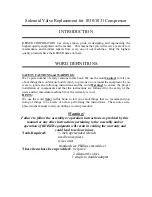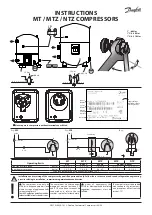
10
3.
Position the unit on flat ground and lock the parking brake before releasing the
unit from the towing vehicle. Should the compressor not feature a parking brake,
immobilise the compressor by placing some wedges in front or behind the wheels.
4. The operator should avoid getting in the way of any released compressed air as
the force of the air speed may cause injury to those directly in its path. Never direct
the air jet directly onto your own body or anybody else. Never use compressed air
to dry your garments.
5. Should it be used for cleaning equipment, proceed with extreme caution using
protective goggles.
6. Should the machine need to operate in closed environments, it is necessary to
convey the exhaust gas to the exterior using a special duct pipe (a stainless steel
spiral pipe is recommended with a diameter of at least 60 mm, the length of which
should be as short as possible. It is also necessary when working in closed
environments to create a ventilation system that conveys the any dirty, hot or dust
saturated air externally, to ensure that the machine can take in air that is fresh and
clean.
7. However the operation of the machine in any closed environments with
atmospheric conditions in which it is possible to find corrosive or explosive gas
vapours or mixtures is
severely prohibited
.
8. When operating in open areas it is necessary to position the machine in such a
way as to ensure that on exit of the discharge gas it occurs on the lee side and
never in the direction of walls or other obstacles, which might oppose the exit and
the dispersion of such exhaust gases.
9. When undertaking any demolition, drilling or sandblasting operations or any
similar operations that tend to generate dust, the tool needs to be connected to the
compressor used a flexible hose that is pressure resistant and of sufficient length to
permit the machine to be distanced from the working area, thereby avoiding the risk
of any clogging of either the suction filters on the unit or of the cooling radiator used
to cool lubricant and coolant liquids. Once again the operator should ensure that
the machine is positioned leeward in relation to the working area.
10. The machine has been designed and constructed to work with bonnet lowered and
therefore it
must not
be kept raised with the engine running, because as well as
generating high noise levels which are harmful it would also jeopardize the
necessary internal ventilation that is essential to ensure correct compressor
function.
11. Position the machine away from the walls and take all the necessary precautions to
ensure that the hot air discharged from the engine and from the cooling systems is
not recycled. Should it be conveyed back into the engine or ventilator there is a risk
of machine overheating.
12. When selecting flexible hosing to connect the machine to the tool, it is important to
ensure that they are of the correct dimensions, in terms of length, the air volume
involved and the working pressure. In fact if the piping is too small in diameter or of
excessive length, there is a risk of blocking the air flow, with a loss in charge and
reduced tool performance. Never use worn, damaged or faulty hoses.
13. The hosing used to convey the compressed air from the machine to the tool, or to
any other appliance that may be applied, must have a cock at one end of the hose
connection, this cock should be kept closed when connecting the hosing to the tool
and the machine in order to prevent the risk of accidental opening of the cock itself
with the consequent risk of severe wobbling of the hosing itself, and even a risk of
Содержание MDVN 71 AP
Страница 2: ...2...











































